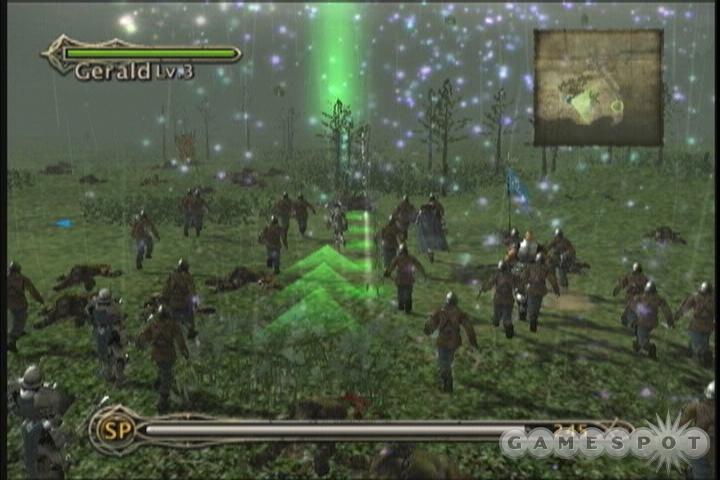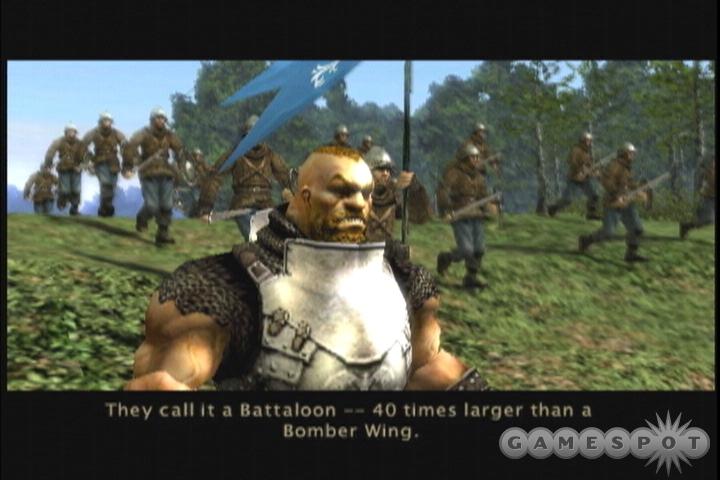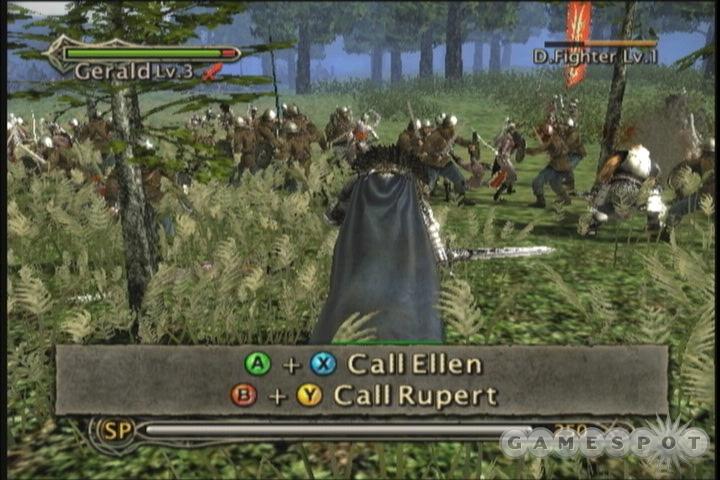Kingdom Under Fire: The Crusaders Preview
We check out Microsoft and Phantagram's promising hybrid of action and strategy for the Xbox.
Once upon a time, in the waning days of the 32-bit era, Sega's Saturn console was graced with an original game named Dragon Force, which put you in command of vast sprite armies as you battled for control of a continent. Despite the game's cult popularity, it seemed that the closest thing audiences would ever see to that style of game would be the historical offerings from Koei's Romance of the Three Kingdoms titles. However, we're pleased to say that good things come to those who wait--as evidenced by Kingdom Under Fire: The Crusaders.

The game, which started in 2001 on the PC with a solid albeit flawed game called Kingdom Under Fire: A War of Heroes, is the latest entry in the strategy series from developer Phantagram. For the Xbox-exclusive, second entry in the series, Phantagram has revamped the gameplay into a real-time hybrid of action and strategy. The end result is a promising game that is the spiritual successor to the style of gameplay seen in Dragon Force, with online play wrapped up in impressive visuals. We recently got ahold of a work-in-progress version of the game to see how everything is coming together and have been left anxiously awaiting the final game.
Kingdom Under Fire: The Crusaders' story is set 50 years after the end of the original game and finds the good and noble Human Alliance once again at war with the down and dirty Dark Legion. Following the massacre of many villagers who lived near a sacred land that was once a battleground for the Dark Legion, the Human Alliance decides that war is on once again and dispatches it forces to drive back the Legion. The single-player game gives you a total of four characters to play as, each with his or her own unique campaigns rated on difficulty. When you first start the game, you'll only have two of the campaigns to choose from. Gerald, a human captain in the Hironeiden Eastern Defense Force, has the easy campaign. Lucretia, a dark elf captain in the Vellond troop who sports a bad temper and mighty cleavage, has the normal campaign. The remaining two campaigns require some work before you can play them. Regnier, the imposing Lord of Hexter (who is obviously a big fan of evildoing), requires you to complete Lucretia's campaign before playing through his hard one. Finally, Kendal, general of the Second Division Ecclesian Holy Knights, requires you to finish Gerald's campaign before you can access his more challenging, hard campaign.
The game's structure is broken up into three basic phases--party management, tactics mode, and battle mode. Party management finds you kicking back in your camp and picking one of five options: operations, barrack, pub, training, and main gate. Operations is where you'll talk with your superiors to get information on where to go next. The barrack lets you manage your forces in a number of different ways. You can change the officers who assist you in battle once you've earned enough to have a selection. You can also upgrade the skill, equipment, and special abilities of your hero and officers as they level up through earning experience from combat.
You can perform similar maintenance on your troops, although there are some notable differences. You can change your troops' skills to access new jobs for them on a large job tree. The system is surprisingly robust and features a plethora of different troop types to experiment with. For example, the human side has infantry, archers, cavalry, sappers (units specializing in various disciplines, such as setting traps and fires), paladins, and storm riders (aerial units), to name just a few. The Dark Legion features comparable forces, albeit given a slightly darker spin. To wit, you'll see cavalry archers, orc-ghouls (a melee unit capable of self-destructing), scorpions (living, siege weapons), swamp mammoths (massive infantry killers), and black wyverns (the Dark Legion's counterpart to the human storm rider). You can purchase and equip new gear for your forces as well.

You can also keep tabs on your troops' resistances, which denote how they can handle different attacks. For example, troops with a high melee resistance will be able to last longer in melee combat. While the resistance values are fixed to the jobs that you assign to your units, you can still improve them by putting the right equipment on your forces. The pub option lets you eavesdrop on your men, which often provides useful bits of information, and it lets you hire mercenaries to bolster your forces. Training lets you learn the basics on movements and issuing commands, and it even lets you earn a modest amount of experience for your time. Finally, the main gate sends you out to the world map.
When on the map, you'll be able to move your cursor to specific locations, which puts you into tactics mode and lets you deploy your forces (as you see fit) on the battlefield. Troop movement is handled in real time and requires you to manage your forces carefully. You'll be able to move your forces en masse or in smaller groups to surround your foes, or you can send in specific types of units to battle against specific types of enemies. For example, you'll want to make sure you pit spearmen against mounted cavalry forces, because their pointy spears make short work of both horse and rider. When deploying troops, you'll be able to choose between three different configurations--normal, tight, and wide. Each, of course, has its unique benefits. Normal is a standard formation, while wide is a broader troop arrangement that allows for faster deployment--at the expense of making your soldiers susceptible to attack. The tight troop formation reduces your speed considerably, but it also ensures maximum protection from archer attacks.
When you finally clash with your opponent's forces, the game shifts to a traditional third-person-play mechanic that puts you in control of your chosen hero and lets you take a hands-on approach to combat by allowing you to wail on your foes. Although your forces will be facing mobs of opposition, you can usually thin their ranks out pretty quickly by dispatching their leader in battle first, which sends your foes scurrying away. At the end of each battle, you'll earn skill points, gold, and experience that will all come in handy when you're looking to upgrade at your camp.

While you'll find yourself minding vast armies of troops, as well as controlling your hero, the control scheme in Kingdom Under Fire: The Crusaders acquits itself admirably during the two phases of combat. When you're moving your forces on the battlefield, you'll use the left analog stick to point them in the proper direction, and you'll use the A or Y button to send them on their way. You'll use Y to send all your troops out and A to send just the group type you've selected. The white and black buttons on the Xbox controller will let you toggle between the different formations--normal, tight, and wide. The left and right triggers will let you toggle between different troop types. You'll also use the D pad to call up a skill menu that you can use to trigger unit skills, such as scouting or archery.
When you engage your foes and take control of your hero, you'll use the left analog stick to move him or her, and you'll use X and Y to pull off attacks. Double-tapping the Y button will let you perform special moves that dole out much pain to your foes--at the cost of skill points. B will let you block attacks, and, if you time your button press properly, it will also let you perform a counterattack that causes damage to your attacker and recoups some skill points for you. Holding down Y and B or X and A will call on one of your officers to perform a support attack that takes out enemies. The setup works well and feels similar to the experience offered by Koei's Dynasty Warriors games.
The graphics in the game offer a good mix of Xbox-effective heavy visuals and solid art design, even if they're not exactly cutting edge. The characters are large and detailed, which is especially slick when you start to get in to the bigger battles that feature hordes of bodies onscreen. The only hitch is their somewhat stiff animation, but this hardly ruins the experience. The environments are a mix of different geographical types that are all well done, although it can be a little tough to follow the action in the heat of battle in areas with tall grass. This actually touches on a rough spot in the game's presentation: its camera. While Kingdom Under Fire: The Crusaders features some inspired camera work during its in-game cinematics, your view during battles can be problematic at times due to awkward angles. To be fair, you can adjust the camera with the right stick during battle, but it can be tricky to do when you're busy dealing out death. Another slight blemish to the visuals is an occasionally inconsistent frame rate that crops up depending on how crowded things get onscreen.

The game's audio clearly follows the Koei model of decent-to-bland voice acting and heavy rock music mixed with good sound effects. The cast of characters, both good and evil, is a talkative bunch, and it banters quite a bit during the game. You'll hear your main character talking with his supporting officers throughout combat, during in-game cinematics, and in between battles while you manage your forces. The voice acting runs the gamut from decent to bland, which is basically fine, although we would have liked to have heard better. The weak spot is forgivable, however, thanks to a good assortment of cries on the battlefield. The music in the game is a guitar-heavy mix of tunes that, while not exactly matching the medieval look, suits the action.
While Kingdom Under Fire: The Crusaders may have been running below the radar these past few months, don't let its low-key status fool you. The game's meaty assortment of campaigns, strong presentation, and rich gameplay makes for a convincing package. The online head-to-head play, via Xbox Live, and its downloadable content add to the game's already considerable appeal. While we're hoping Phantagram tweaks a few of the rough spots we've mentioned, Kingdom Under Fire: The Crusaders is still shaping up to be a solid game that will well be worth a look when it ships this August exclusively for the Xbox.
Got a news tip or want to contact us directly? Email news@gamespot.com
Join the conversation